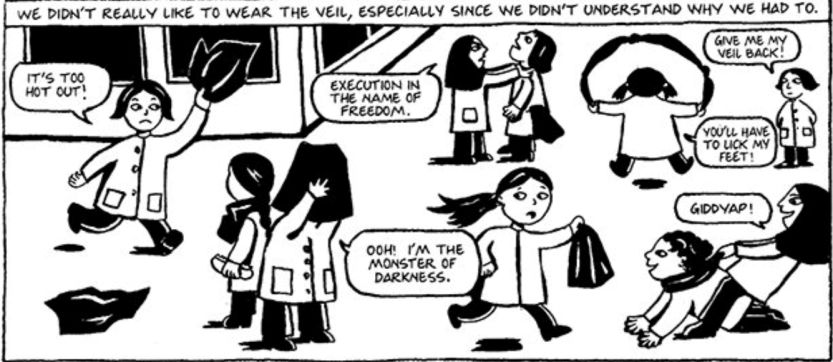The Veil In Persepolis By Marjane Satrapi
May 31, 2019 • 18 views
The veil, figuratively,is used when something is to be concealed. Here in Persepolis, the veil is the compulsion of the Iranian tradition. It is imposed by the regime, to cover women up. It is shown to conceal aspects of simple human anatomy that are natural. Women, here, are objectified for exciting men, which goes to say that, they believe that abuse or molestation of women is to some extent the women’s fault. This is just another take at victim blaming and Satrapi as a young girl is brought up to observe all this misuse of the power by the regime in repressing women. The veil in the novel is used as a pictorial representation of the bounds and limitations set by the regime. It symbolises how by dictating how to dress and look, the regime is holding an authority over all the women of Iran and denying them the basic freedom of expression.
However, she receives complete freedom from her family, especially her grandmother who is strictly against the veil. As it is uncomfortable in the scorching heat, uneasy to wear as an attire and can be disliked for very simple reasons that it gets extremely exhausting to wear the same conventional clothes over and over again. The veil is brought up several times in the novel, every time, in order to refrain from the freedom of expression. From her childhood to her transition to adulthood we can distinctly see that she, herself, finds the idea of veil vaguely absurd.

1.

2.
Decoding the frames:
These two frames are located in a playground, with an outsider’s view. A lot of similarities can be seen in these two frames. For instance, we can see the same girl who is being scared by the boy in the mask in the second frame, being scared by the girl wearing the veil as a scary mask in the first frame. Here, the veil is just another play-thing for them, for obvious reasons, them being ten, they don’t really know what it implies. As a child, they would treat it as they treat everything else — with curiosity and just another source to have fun or to play with.
In the first frame, the girl on the far left is holding the veil in the air, saying “It’s too hot out!” She finds the veil uncomfortable, whereas everyone else here can be seen playing with the veil. They are using it as a skipping rope or a leash. In the second frame, we can see both boys and girls playing on the playground, as it being a co-ed school. The major distinction in between these two frames is the change in uniform of the school. In the second frame, the boys are seen in shorts and the girls in skirts. In the first frame, all the girls are wearing pants, full-sleeved tops and the veil in the heat. This could be considered as an after and before picture. Here the major change in the life of children before and after the revolution can be seen. However, their innocence is preserved but the regimes imposition are still prominent in these frames.
